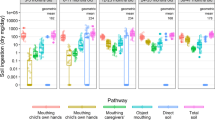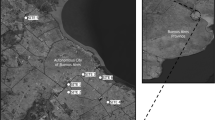Summary
In recent years, many cases of soil pollution have been unearthed in the Netherlands. The ingestion of soil particles due to mouthing behaviour of young children is an important potential pathway of exposure and may constitute a health risk. For an assessment of these health risks, a reliable estimation of the daily inadvertent ingestion of soil particles is necessary. A method to estimate soil ingestion is the use of titanium (Ti), aluminium (Al) and acid insoluble residue (AIR) content of the soil as a tracer. By measuring these tracers in feaces of children and in soil, an estimate can be made of the amount of soil ingested. This method can be used if the following conditions are met: tracer intake by other routes (food) is low and not too variable; tracer absorption from soil in the gastro-intestinal (GI) tract is negligible; tracer concentrations in soil are high and not too variable. A small pilot study was conducted among 18 children visiting a nursery school and 6 hospitalized children without any possibility of soil contact. The results of the pilot study indicate that each tracer is present in faeces in highly variable amounts, but that a combination of these three tracers produces a useful picture of potential soil ingestion. Quantitatively, a difference between the two populations of 55 mg/d, expressed as soil ingestion, was found. Despite the small numbers involved, this difference was statistically significant as the population standard deviations were small. In a number of different soil types, tracer concentrations were found to be almost equal. Further studies are planned to test the validity of the assumptions, and to investigate larger child populations living in different circumstances.
Similar content being viewed by others
References
Barltrop D (1966) The prevalence of pica. Am J Dis Child 112:116–123
Berlin M (1977) Titanium. In: Toxicology of metals — Volume II, EPA, May 1977
Berry WL, Krizek DT, Ormrod DP, McFarlane JC, Langhans RW, Tibbits TW (1981) Variation in elemental content of lettuce grown under base line conditions in five controlled-environment facilities. J Am Soc Hort Sci 106:661–666
Bowen HJM (1982) The elemental content of human diets and excreta. Environ Chem 2:70–93
Brunekreef B, Noy D, Biersteker K, Boleij JSM (1983) Blood lead levels of Dutch city children and their relationship to lead in the environment. J Air Poll Control Assoc 33:872–876
Charney E (1982) Lead poisoning in children: the case against household lead dust. In: Chisholm JJ and O'hara DM (eds) Lead absorption in children. Urban and Schwarzenberg, Baltimore/Münich, pp 79–88
Cherney JH, Robinson DL, Kappel LC, Hanbry FG, Ingraham RU (1983) Soil contamination and elemental concentrations of forages in relation to grass tetany. Agron J 75:447–451
Duggan MJ, Williams S (1977) Lead in dust in city streets. Sci Total Environ 7:91–97
Emmons WH, Thiel GA, Stauffer CR, Allison IS (1960) Geology: principles and processes. 5th ed. McGraw Hill, New York, p 60
Ferguson JE, Ryan DE (1984) The elemental composition of street dust from large and small urban areas related to city type, source and particle size. Sci Total Environ 34:101–116
Flanagan FJ (1973) 1972 values for international geochemical reference samples. US Geological Survey USA. Geochim Cosmochim Acta 37:1189–1200
Geigy Scientific Tables (1973) Diem K, Lentner C (eds) 7th ed, Ciba-Geigy Limited, Basle, Switzerland, p 657
Healy WB (1968) Ingestion of soil by dairy cows. N Zeal J Agric Res 11:487–499
Healy WB, Ludwig TG (1965) Wear of sheep's teeth. I. The role of ingested soil. N Zeal J Agric Res 8:737–752
Kimbrough RD, Falk H, Stehr P, Fries G (1984) Health implications of 2, 3, 7, 8-TCDD contamination of residential soil. J Toxicol Environ Health 14:47–93
Mayland HF, Florence AR, Rosenau RC, Lasar VA, Turner HA (1975) Soil ingestion by cattle on semiacid range as reflected by titanium analysis of faeces. J Range Manage 28:448–452
McLaren JW, Berman SS, Boyko VJ, Russell DS (1981) Simultaneous determination of major, minor and trace elements in marine sediments by inductively coupled plasma atomic emission spectrometry. Anal Chem 53:1802–1806
Metson AJ, Gibson EJ, Hurnt JL, Saunders WMH (1979) Seasonal variations in chemical composition of pasture. III. Silicon, aluminium, iron, zinc, copper and manganese. N Zeal J Agric Res 22:309–318
Nes P (1975) A correction for soil contamination of herbage samples by dry ashing. N Zeal J Agric Res 18:69–71
Roels HA, Buchet JP, Lauwerijs RR et al. (1980) Exposure to lead by the oral and pulmonary routes of children living in the vicinity of a primary lead smelter. Environ Res 22:81–94
Sorenson RJ, Campbell JR, Tepper LB, Lingg RD (1974) Aluminium in the environment and human health. Environ Health Perspect 8:3–95
Thornton J, Abrahams P (1981) The role of soil ingestion in the intake of metals by livestock. In: Trace substances in environmental health XV. DD Hemphill (ed) Univ of Missouri, Columbia, pp 366–371
Vostal JJ, Tabes E, Sayre JW, Charney E (1974) Lead analysis of house dust: a method for the detection of another source of lead exposure in inner city children. Environ Health Perspect 7:91–97
WHO (1982) Environmental health criteria 24, Titanium
Ziegler EE, Edwards BB, Jensen RL, Mahaffey KR, Fomon SJ (1978) Absorption and retention of lead by infants. Pediatr Res 12:29–34
Author information
Authors and Affiliations
Additional information
The study was supported by the Ministry of Housing, Urban Planning and the Environment
Rights and permissions
About this article
Cite this article
Clausing, P., Brunekreef, B. & van Wijnen, J.H. A method for estimating soil ingestion by children. Int. Arch Occup Environ Heath 59, 73–82 (1987). https://doi.org/10.1007/BF00377681
Received:
Accepted:
Issue Date:
DOI: https://doi.org/10.1007/BF00377681




